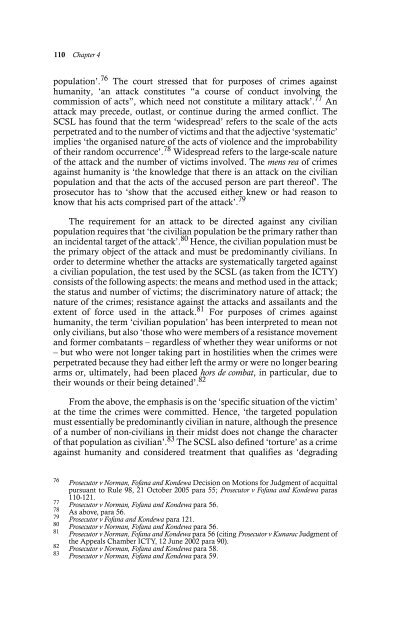Prosecuting International Crimes in Africa - PULP - University of ...
Prosecuting International Crimes in Africa - PULP - University of ...
Prosecuting International Crimes in Africa - PULP - University of ...
Create successful ePaper yourself
Turn your PDF publications into a flip-book with our unique Google optimized e-Paper software.
110 Chapter 4<br />
population’. 76 The court stressed that for purposes <strong>of</strong> crimes aga<strong>in</strong>st<br />
humanity, ‘an attack constitutes “a course <strong>of</strong> conduct <strong>in</strong>volv<strong>in</strong>g the<br />
commission <strong>of</strong> acts”, which need not constitute a military attack’. 77 An<br />
attack may precede, outlast, or cont<strong>in</strong>ue dur<strong>in</strong>g the armed conflict. The<br />
SCSL has found that the term ‘widespread’ refers to the scale <strong>of</strong> the acts<br />
perpetrated and to the number <strong>of</strong> victims and that the adjective ‘systematic’<br />
implies ‘the organised nature <strong>of</strong> the acts <strong>of</strong> violence and the improbability<br />
<strong>of</strong> their random occurrence’. 78 Widespread refers to the large-scale nature<br />
<strong>of</strong> the attack and the number <strong>of</strong> victims <strong>in</strong>volved. The mens rea <strong>of</strong> crimes<br />
aga<strong>in</strong>st humanity is ‘the knowledge that there is an attack on the civilian<br />
population and that the acts <strong>of</strong> the accused person are part there<strong>of</strong>’. The<br />
prosecutor has to ‘show that the accused either knew or had reason to<br />
know that his acts comprised part <strong>of</strong> the attack’. 79<br />
The requirement for an attack to be directed aga<strong>in</strong>st any civilian<br />
population requires that ‘the civilian population be the primary rather than<br />
an <strong>in</strong>cidental target <strong>of</strong> the attack’. 80 Hence, the civilian population must be<br />
the primary object <strong>of</strong> the attack and must be predom<strong>in</strong>antly civilians. In<br />
order to determ<strong>in</strong>e whether the attacks are systematically targeted aga<strong>in</strong>st<br />
a civilian population, the test used by the SCSL (as taken from the ICTY)<br />
consists <strong>of</strong> the follow<strong>in</strong>g aspects: the means and method used <strong>in</strong> the attack;<br />
the status and number <strong>of</strong> victims; the discrim<strong>in</strong>atory nature <strong>of</strong> attack; the<br />
nature <strong>of</strong> the crimes; resistance aga<strong>in</strong>st the attacks and assailants and the<br />
extent <strong>of</strong> force used <strong>in</strong> the attack. 81 For purposes <strong>of</strong> crimes aga<strong>in</strong>st<br />
humanity, the term ‘civilian population’ has been <strong>in</strong>terpreted to mean not<br />
only civilians, but also ‘those who were members <strong>of</strong> a resistance movement<br />
and former combatants – regardless <strong>of</strong> whether they wear uniforms or not<br />
– but who were not longer tak<strong>in</strong>g part <strong>in</strong> hostilities when the crimes were<br />
perpetrated because they had either left the army or were no longer bear<strong>in</strong>g<br />
arms or, ultimately, had been placed hors de combat, <strong>in</strong> particular, due to<br />
their wounds or their be<strong>in</strong>g deta<strong>in</strong>ed’. 82<br />
From the above, the emphasis is on the ‘specific situation <strong>of</strong> the victim’<br />
at the time the crimes were committed. Hence, ‘the targeted population<br />
must essentially be predom<strong>in</strong>antly civilian <strong>in</strong> nature, although the presence<br />
<strong>of</strong> a number <strong>of</strong> non-civilians <strong>in</strong> their midst does not change the character<br />
<strong>of</strong> that population as civilian’. 83 The SCSL also def<strong>in</strong>ed ‘torture’ as a crime<br />
aga<strong>in</strong>st humanity and considered treatment that qualifies as ‘degrad<strong>in</strong>g<br />
76<br />
77<br />
Prosecutor v Norman, F<strong>of</strong>ana and Kondewa Decision on Motions for Judgment <strong>of</strong> acquittal<br />
pursuant to Rule 98, 21 October 2005 para 55; Prosecutor v F<strong>of</strong>ana and Kondewa paras<br />
110-121.<br />
Prosecutor v Norman, F<strong>of</strong>ana and Kondewa para 56.<br />
78<br />
79<br />
80<br />
81<br />
As above, para 56.<br />
Prosecutor v F<strong>of</strong>ana and Kondewa para 121.<br />
Prosecutor v Norman, F<strong>of</strong>ana and Kondewa para 56.<br />
Prosecutor v Norman, F<strong>of</strong>ana and Kondewa para 56 (cit<strong>in</strong>g Prosecutor v Kunarac Judgment <strong>of</strong><br />
82<br />
83<br />
the Appeals Chamber ICTY, 12 June 2002 para 90).<br />
Prosecutor v Norman, F<strong>of</strong>ana and Kondewa para 58.<br />
Prosecutor v Norman, F<strong>of</strong>ana and Kondewa para 59.

















